Pre-WWII football and basketball at Oakland City College started and ended with grim events. The Great Depression was one bookend. The world-wide financial collapse closed many small colleges and left many others to struggle desperately for survival. Oakland City College was in the latter category, its vibrancy during the “Roaring Twenties” replaced by a sense of grim determination in the 1930s.
During the 1920s, OCC had especially strong basketball, football, and track teams. The Oaks competed against the various small colleges in Indiana and Illinois and against state schools such as Indiana State, Ball State, and Central Normal, along with out-of-state schools such as the University of Louisville and Southern Illinois University.
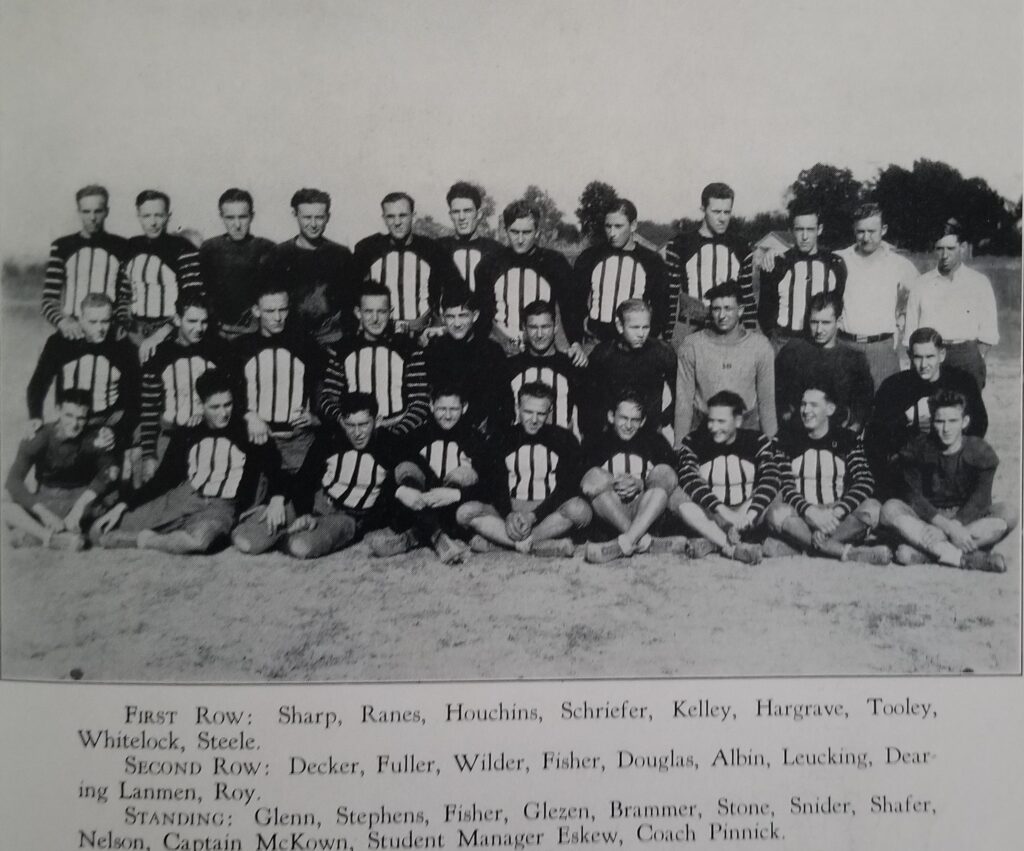
When the depression hit, the college’s sports program suffered, the cost of transportation and overnight stays limiting the athletic programs. The biggest problem, however, was that the depression also witnessed fewer males entering OCC.
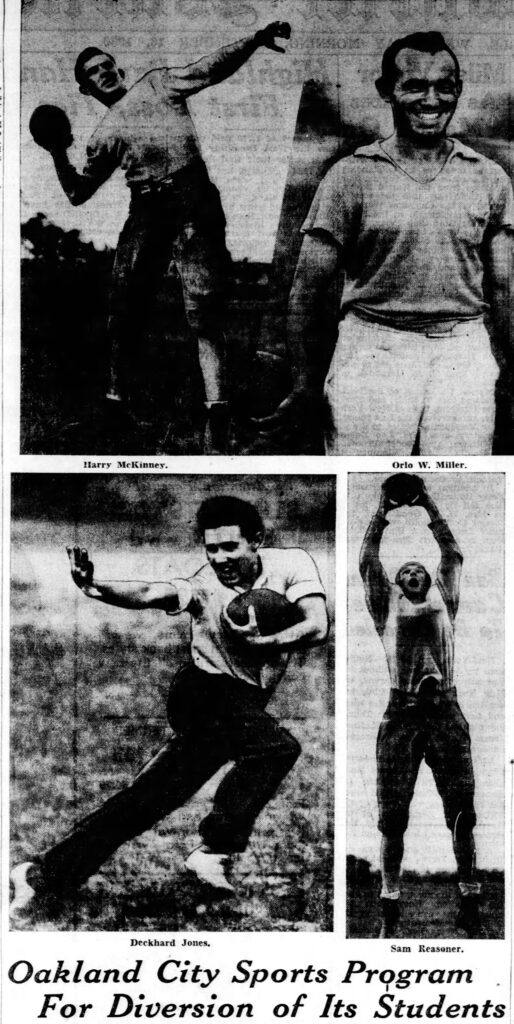
The football program at OCC was the first casualty of the nation’s financial collapse. In the 1920s, the college had played state school such as Ball State and Indiana State in football, along with the many small colleges that dotted Indiana. Evansville College was OCC’s biggest rival, and the Oaks were able to knock down the big city team occasionally, along with wins over Ball State and the University of Louisville in football in that decade.
As fewer males enrolled at the beginning of the 1930s, football wins dwindled. The high point was reached in 1933, when the team won half their games and defeated arch-rival Evansville College in their homecoming game. After that, the Oaks would not win a game over next three years.
An article about the team in the Louisville Courier-Journal in 1936 lamented some of the hurdles the tiny school had to deal with when putting out a football team.
Six members of the Oakland City team last year never had played football, and Mr. Miller [coach] has three fellows on his squad of twenty this year who never played the sport. Two of these are expected to be regulars. One of the boys, “Sekatary” Hawkins, who weights 170 pounds and who comes from Mt. Olympus, Ind., never has seen a football game.
The article also highlighted OCC’s strong track tradition, noting the school had “the second fastest 100-yard dash man in the state.” Further highlighted was the school’s handsome young football and basketball coach, Orlo Miller. Miller had been an exceptional athlete at Ball State, excelling at football, baseball, and basketball. The sportswriter noted that he found “Orlo W. Miller adequately equipped for all the tasks assigned to him—and thriving on them.”
Regardless of Coach Miller’s ability, the school was unable to bring in enough players to maintain the football program. In November 1937, the school called it quits on football, the school’s withdrawal from the sport making national news.
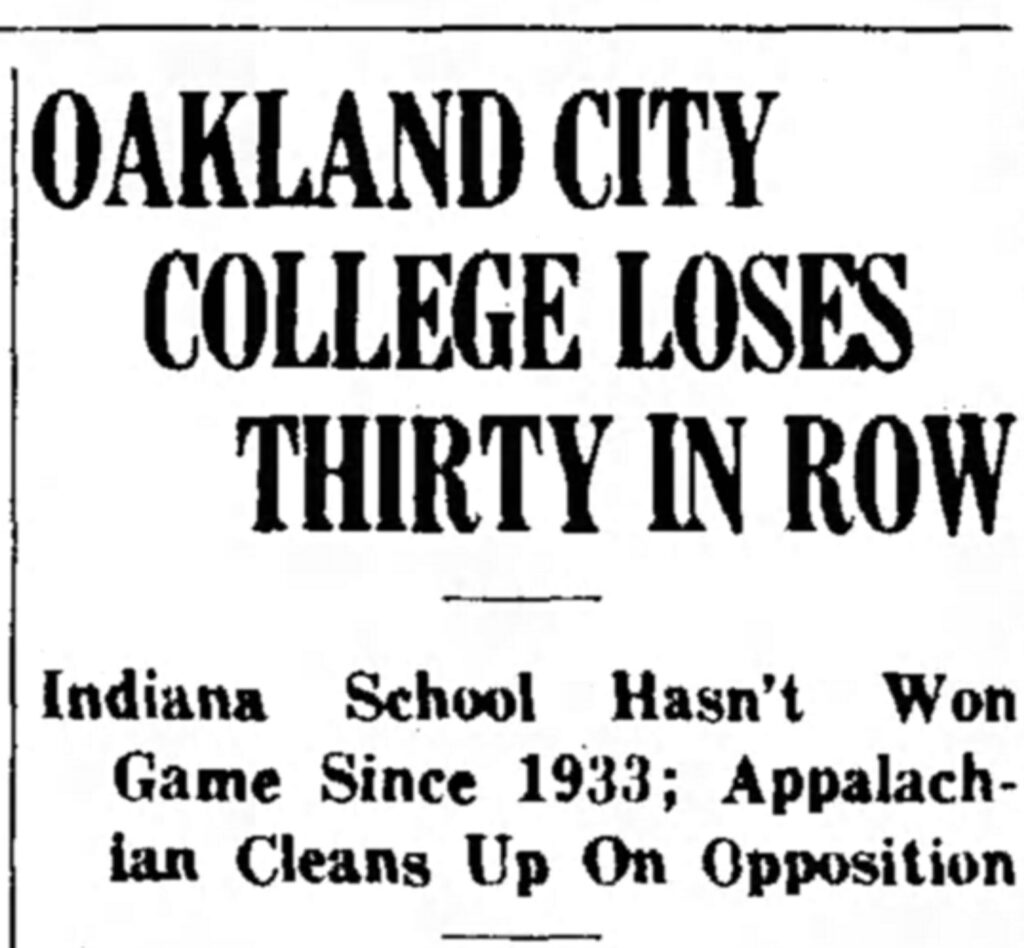
Oddly, while the Oaks were suffering a deathblow in football, the basketball team was doing well. The Oaks ended up with a respectable 7-8 record during the 1936-1937 season, playing strongly in every game, and shocking the University of Louisville 41-33 at the Oakland City gym. Coach Miller had a tall lanky freshman from Stendal, Indiana–Bill Spradley, who stood six feet four inches tall and played the center position. He was the team’s leading scorer that year. Against Louisville, Spradley had eleven points, while senior Orrin Stuckey threw in twelve.
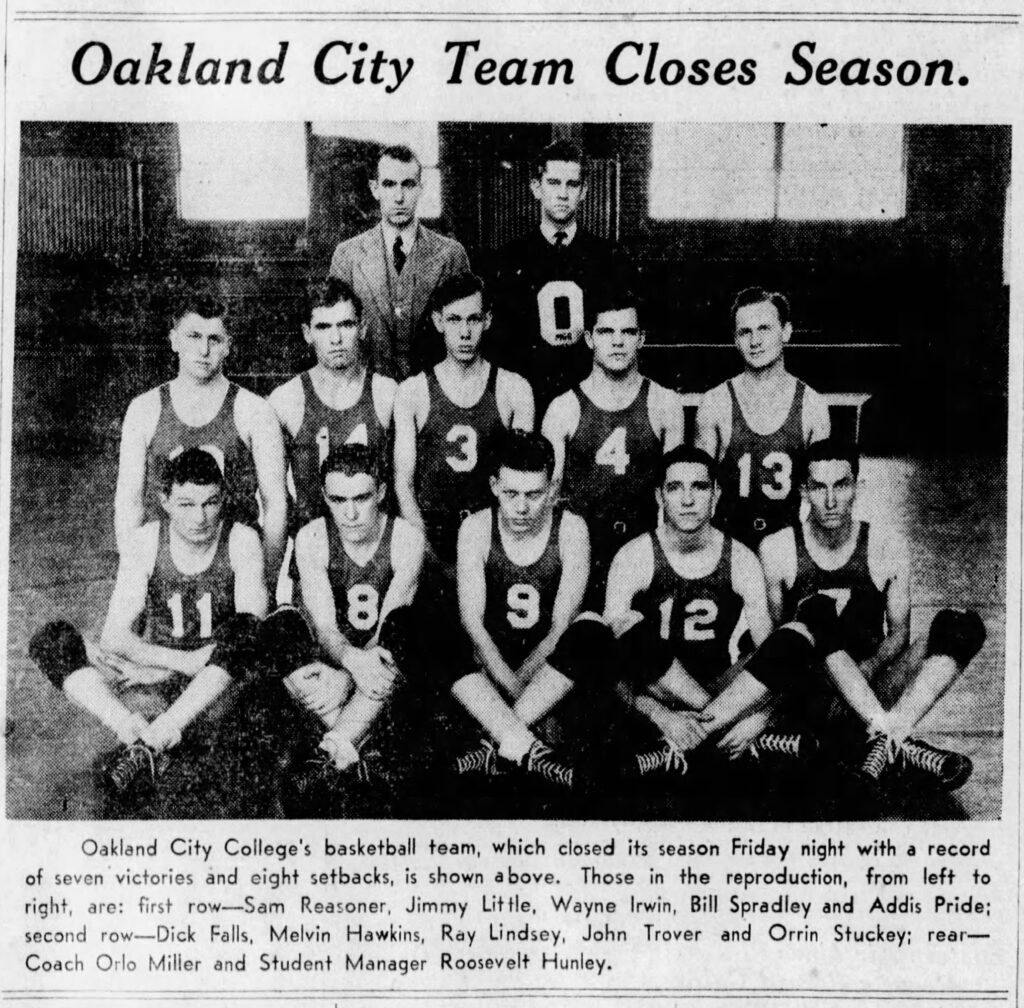
The 1937-1938 campaign turned out as solid as the year before, with Bill Spradley leading the team to victory in what a Muncie Star sports reporter described as “a wild, free-scoring game” against rival Evansville College, 50-41. The local Princeton Daily Clarion noted the Oaks staged “a powerful attack before an unusually large crowd here last night” in its victory against the Evansville team.
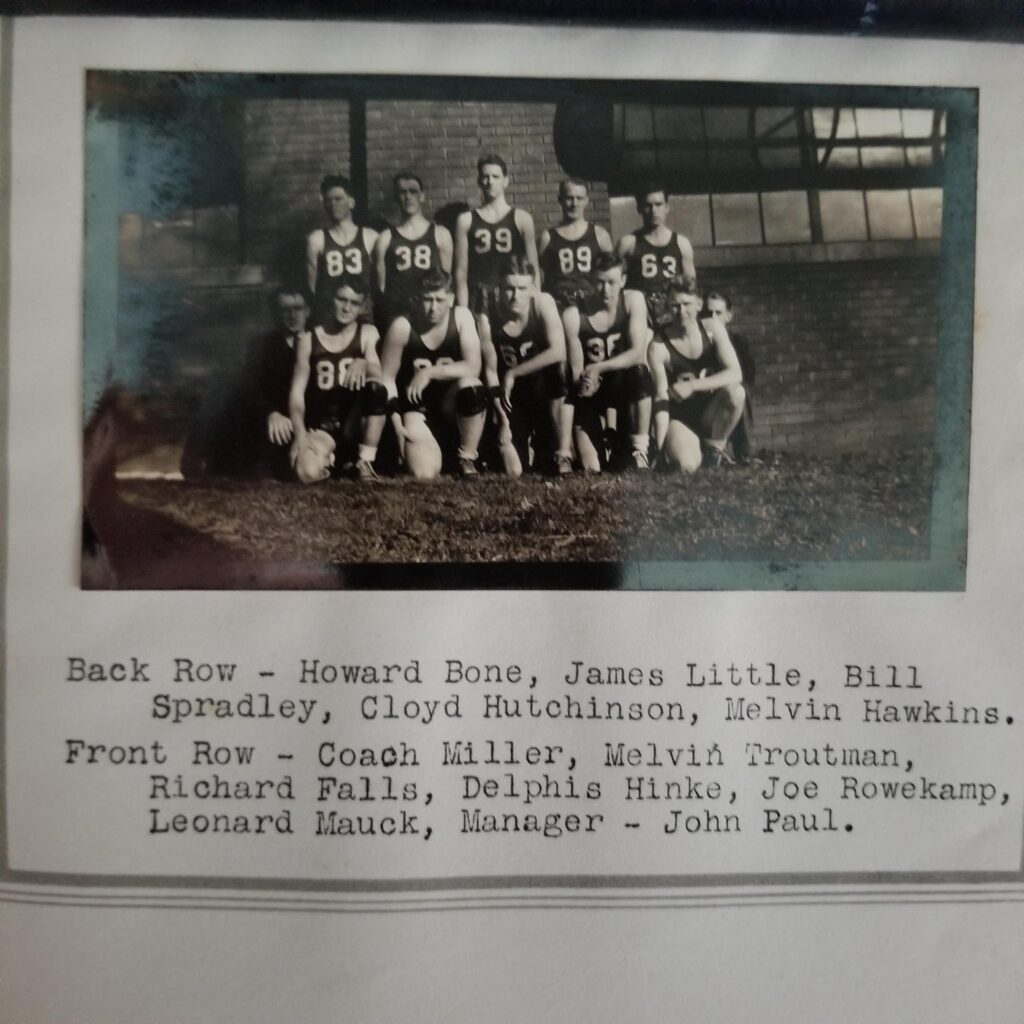
The next day after the Evansville win, a Wednesday, the town of Oakland City went wild, the Princeton newspaper reporting:
Led by the Oakland City College band, fans of this city paraded throughout yesterday. The match extended over the city, with the principal demonstration on Main Street. It was a noisy, happy, and apparently tireless throng of enthusiastic supporters of the Oaks who staged the demonstration. . .. The fine victory of the Oaks created unusual enthusiasm. The team will play Anderson College at Anderson Friday night.
A Wisconsin sportswriter put the victory celebration in perspective, observing, “Credit Oakland City back in Indiana. Last year they gave up football after failing to win one game in three years. But they still can play basketball. They scored a new triumph by beating their “bragging rivals” from Evansville College, 50 to 41.”

The Oaks would go on to be one game under five hundred that year, after playing the likes of Butler, DePauw, Southern Illinois, St. Joseph, Valparaiso, and Indiana State. But their greatest victory was an overtime win over the University of Louisville. Jimmy Cowen, sports editor of the Louisville Courier-Journal certainly had an interesting take on the game.
The University of Louisville cagers dropped a torrid 43-40 overtime decision to the Hoosiers of Oakland City College in one of the rip-snortingest ball games seen at the Cardinal birdhouse in many a moon last night. From the expert’s point of view, it was far from being a well-played ball game, but it was a rip-snorter if there ever was one. Si Monen tossed in one of his neatest loopers from the center of the floor to tie the test with a minute left, sending the near-capacity house into a frenzy that had the walls pulsating.
The game was tied eleven times with the lead changing hands ten times. Once more, big Bill Spradley was the Oaks’ leading scorer.

The next two seasons were down years for the Oaks, Bill Spradley’s name conspicuously absent from the roster for several games, perhaps due to injury. Then came the 1940-1941 season.
The season began with a bang. Spradley led the Oaks to a victory over Wabash College’s Little Giants, making a last second hook shot to send the game into overtime and then scoring the team’s first four and last three points in the overtime to secure the win.
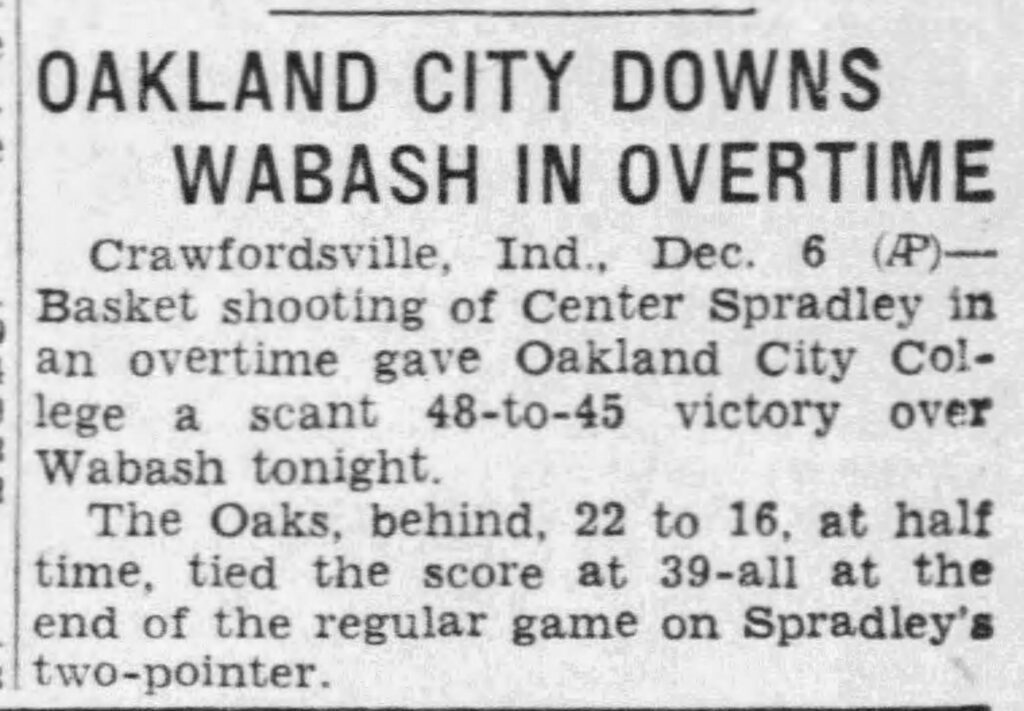
Ken “Tot” Nelson, a new addition to the Oaks team, also contributed to the victory over Wabash, as did Simeon Cato.
Another victory followed for OCC, before the Oaks played a formidable Indiana State team at Terre Haute. While Spradley led all scorers, the Sycamores won by five points, 44-39.
At home against Arkansas State, the Oaks lost “a thrilling battle” with Tot Nelson leading the Oaks’ scoring and Spradley right behind. By January, the team was 4-4, having played solid competition. Then the Oaks really jelled.
On January 20, 1941, the Princeton Clarion reported, “Oakland City College’s basketballers are setting a red-hot pace now. Their top-heavy triumph at Valparaiso last night followed by a win at St. Joseph’s College.”
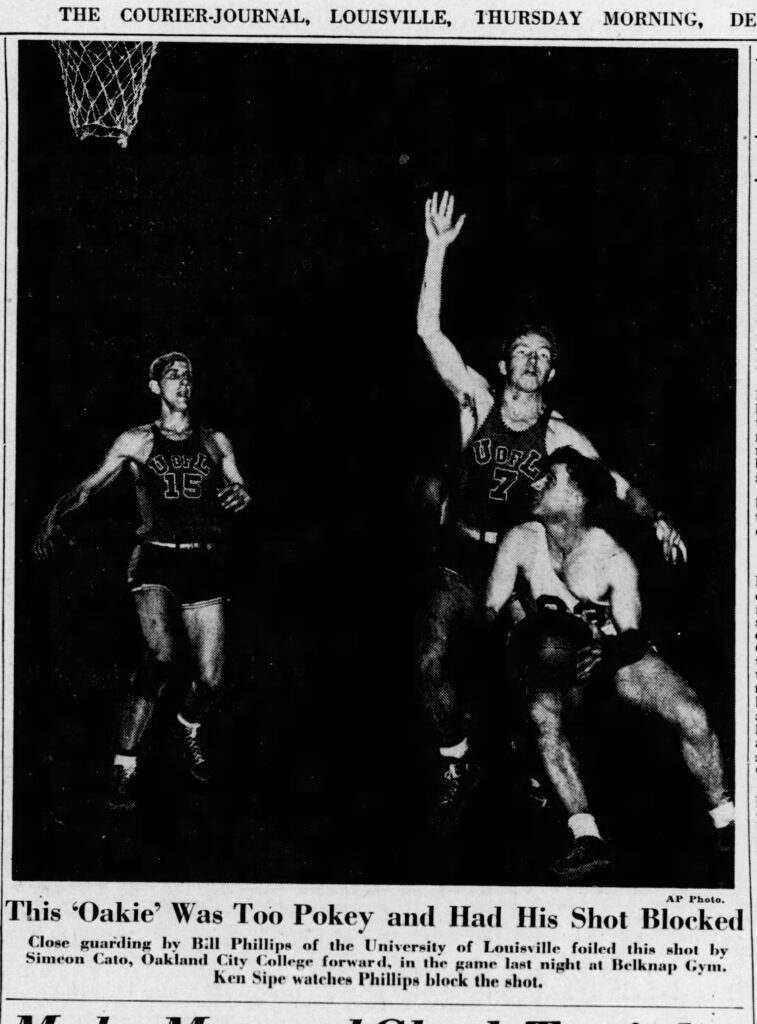
By early February, the Oaks were 7-3, and Spradley was among the leading collegiate scorers in the state. Then came the feat that put the Oaks in the national sports news again and made Bill Spradley a national marvel.
On February 22, 1941, the Oaks played McKendree College of Illinios. The next day, an Akron Beacon Journal sportswriter reported, “McKendree left here today with their heads still in a whirl after taking a 111-60 drubbing last night from the Oakland City College cagers. Spradley, tall Oak center, tossed in 32 field goals and four free throws for a total of 68 points.”
Other newspapers across the nation had a blast with the game’s incredible outcome. The Moline Illinois Dispatch sportswriter, under the title, “Yep, It’s Basketball,” noted the game sounded “more like a track meet score” and added, “not bad, eh what?” The Argus-Leader sportswriter in Sioux Falls, South Dakota, under the heading, “That’s Hooping it up- 32 Field Goals,” observed that “Point-a minute basketball is slow stuff to the Oakland City College team. Center Bill Spradley did better than that himself last night as the Oaks beat McKendree College at Lebanon, Illinois 111 to 66.” The Times Herald, of Port Huron, Michigan, began its report on the game under the playful title, “Close One.” The Sacramento, California Bee simply headlined, “Center Registers 68 points in Cage Game.”
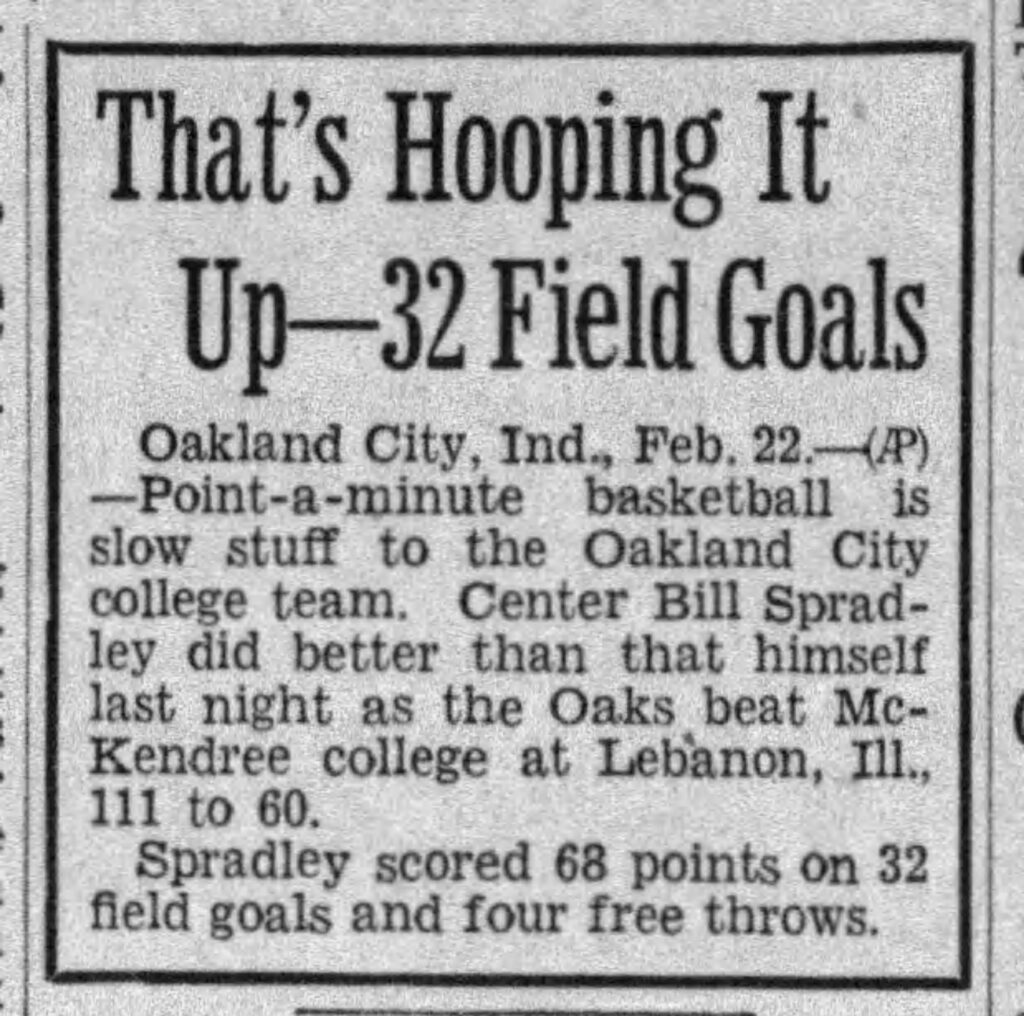
It may have taken the OCC team a while to digest their accomplishments. Bill Spradley’s incredible production set a new individual player scoring record for a national four-year college athlete. The OCC team’s score would also go down as the most points scored in an Indiana college game and Spradley’s efforts would stand as an individual state college scoring record as well. Spradley’s scoring average that year would bring him second place among Indiana players for the 1940-1941 season, just behind future basketball All-American Gus Doerner of Evansville College.
It did not take long for the bubble to burst. Oakland City traveled to the armory in Evansville to play archrival Evansville College. The Indianapolis Star, playing up the game, noted, “Coach Bill Slyker’s Purple Aces meet Bill Spradley and his Oakland City ‘fire-wagon.’ The Purple Aces are undefeated in five league titles.” The game was a rout, however, the Aces wining 66-39. Gus Doerner led the scoring with 21 points for the Aces, while Spradley only tallied 15 for the Oaks.
At the end of the season, Bill Spradley garnered one more honor. He was chosen for second team honors among the players at the smaller, non-state supported Indiana college schools. A Muncie sportswriter observed, however, “Spradley, who many coaches say ‘could play on any team in the country,’ is a player who settled for good the argument as to what Indiana player ever had scored the most points in a single game. His record of 68 points recently against McKendree is a mark no one ever has approached.”
The National Basketball League did not exist in those days, but professional touring teams, such as Harlem Globe Trotters, the New York Renaissance, The Original Celtics, and the Indianapolis Kautskys played one another and other regional teams in arenas and stadiums across the nation. Owners would do unorthodox things to draw crowds, such as waiving foul rules for a game, or tout a yet unseen scoring machine.
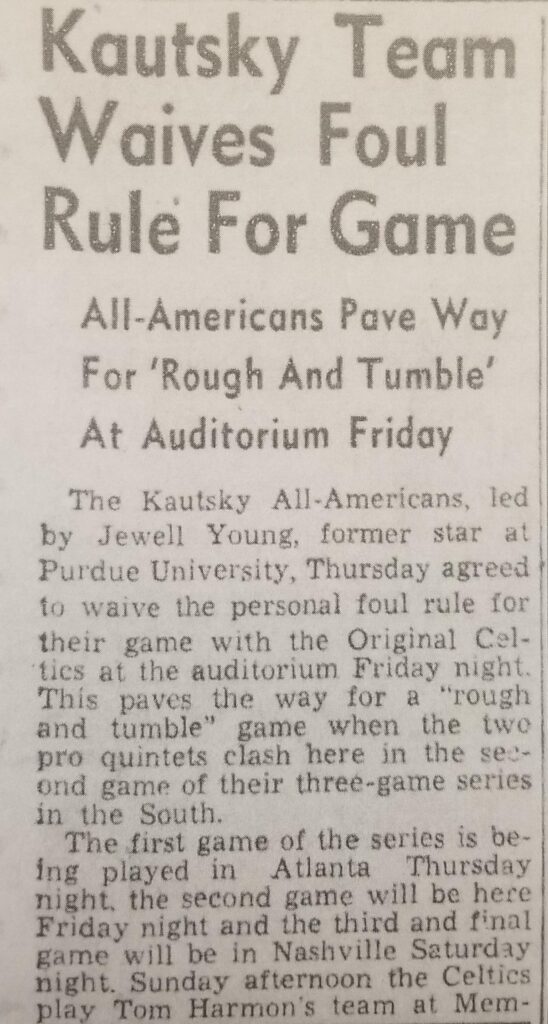
In March of 1941, the Birmingham Alabama News announced that Bill Spradley had signed with a professional barnstorming basketball team, the “Kautsky All-Americans Indianapolis National League team” and that he would be playing in the team’s next contest against the “Original Celtics,” another basketball “barnstorming team” in Birmingham. Spradley’s earlier national scoring feat probably worked as a selling point for the team’s owner, Frank Kautsky, the article headlining “Sensational Scoring Ace Signed by Indianapolis And Will Be Seen Here.”
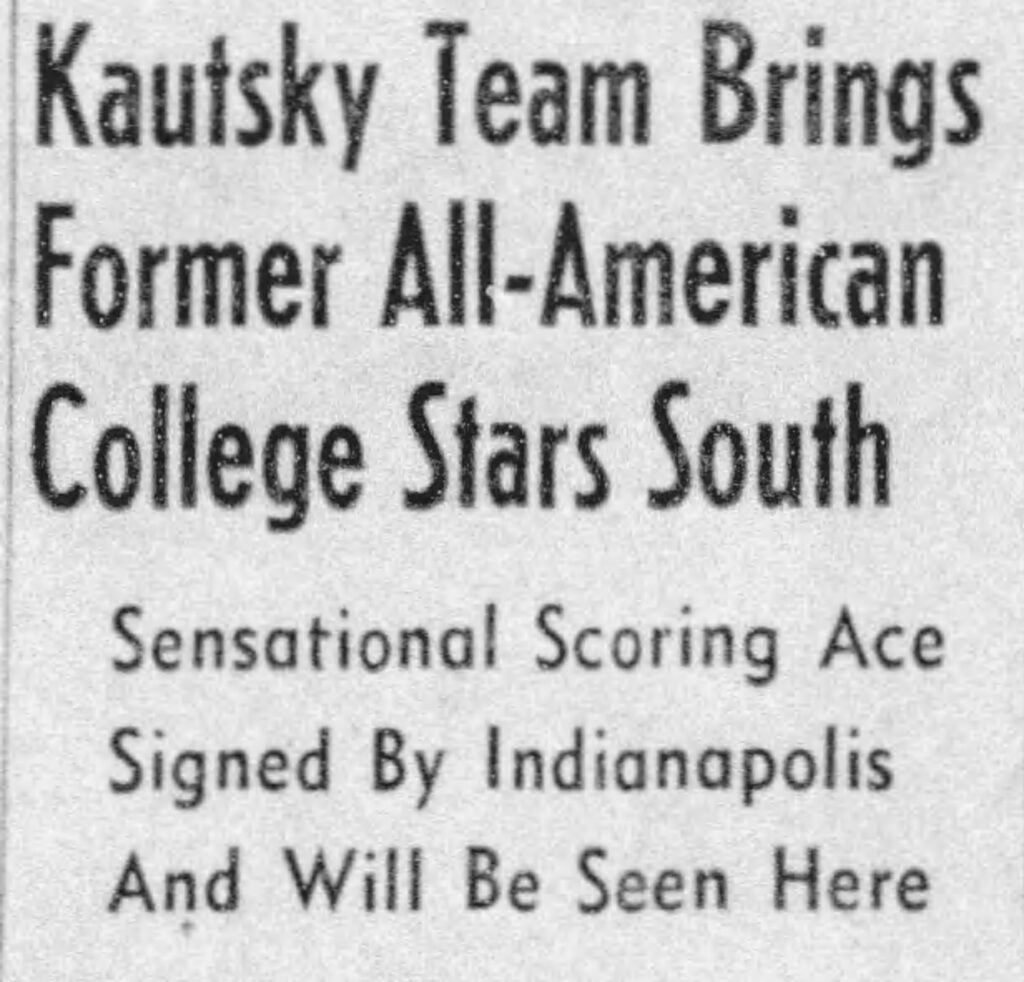
Spradley, however, never got beyond playing on the second team and did not play as a professional long. The nation entered WWII that December, and Bill was soon drafted into the navy where he flew in the Navy air corps. After serving in the war, he came back to Indiana and landed a basketball coaching job at Mitchell High School. His scoring feat, however, was still remembered for some time. A sports reporter for the Cedar Rapids Gazette in 1947, for example, complaining about scoring braggers, explained, “Any time a guy starts yapping about this character or that scored in a cage game, just call attention to the game between Oakland City College and McKendree over in Illinois Feb. 21, 1941. A player named Bill Spradley scored 68 points for the winner– 53 in the last half– as the Oaks won 111-60.”
The other bookend of the era featured in this story concerned WWII. As for Oakland City College sports, the school faced yet another hardship when the war started, the conflict, like the Great Depression, taking many students away and putting financial pressure on the institution. In November of 1942, the school dropped basketball, the Indianapolis Star calling the event “the first college casualty of the war.” The program would not be resurrected until after the war.
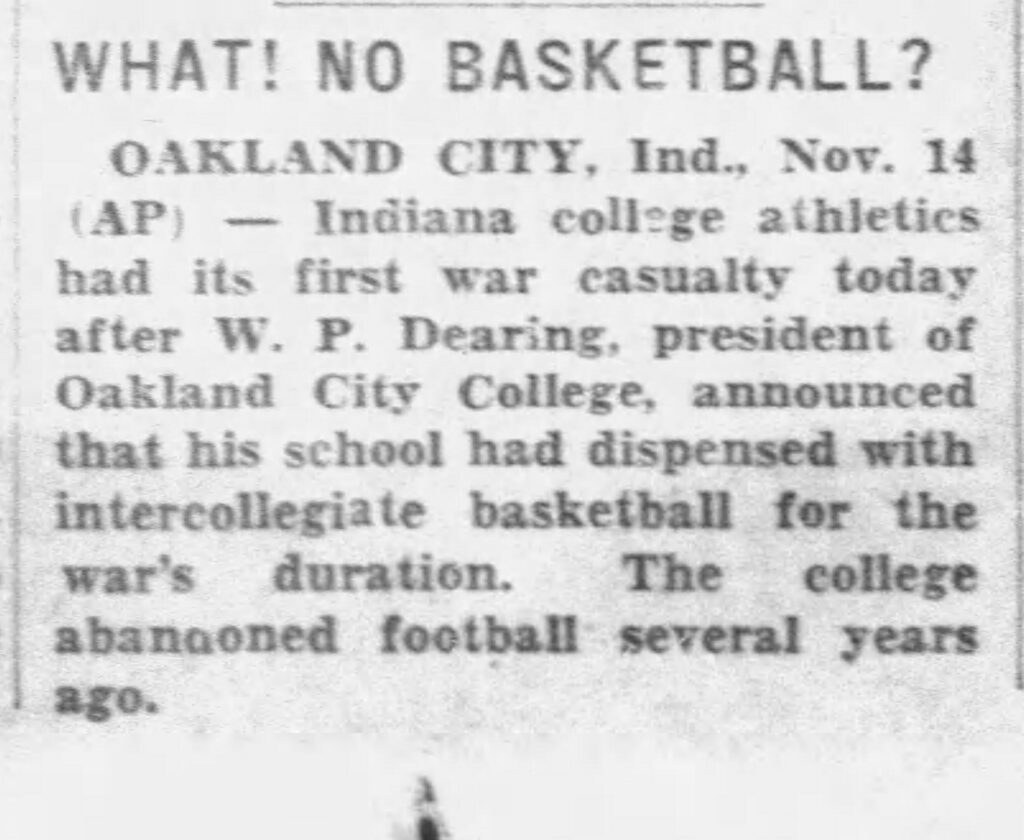
Bill Spradley joined the Indiana high school basketball coaching ranks once he was out of the service in 1945. As for his and Oakland City College’s incredible scoring records, the feats have been all but forgotten in the passage of time. They are records, however, that deserve remembering.